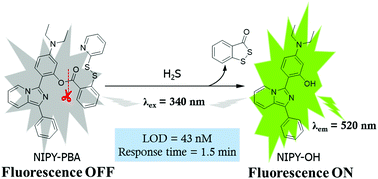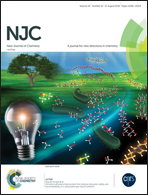A new fluorescent probe for quick and highly selective detection of hydrogen sulfide and its application in living cells†
Abstract
Hydrogen sulfide (H2S) is one of the endogenous regulators of many physiological processes. NIPY-OH based on an imidazo[1,5-α]pyridine has a large Stokes shift, high photostability with green-emission, relatively high fluorescence quantum yield. NIPY-OH could serve as an excellent candidate for the design of fluorescent probes. However, the reported probes cannot sufficiently take advantage of the optical properties of NIPY-OH due to the water-soluble problem. Herein, a new fluorescent probe NIPY-PBA, based on NIPY-OH, was designed for the detection of hydrogen sulfide. By rational design, compared with other probes, we successfully obtained the probe with higher sensitivity (limit of detection = 43 nM) and shorter response time (1.5 minutes) due to better water solubility. NIPY-PBA maintained the excellent optical properties of a 230-fold fluorescence enhancement with a large Stokes shift (208 nm) at the same time. Furthermore, NIPY-PBA was applied for the fluorescence imaging of H2S in living cells with low cytotoxicity, indicating NIPY-PBA has great potential to monitor H2S in biological systems.



 Please wait while we load your content...
Please wait while we load your content...